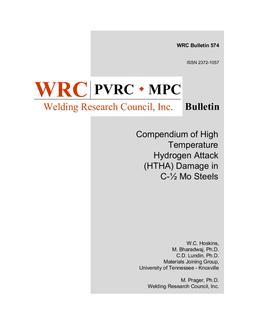Cart 0 Product Products (empty)
No products
To be determined Shipping
$0.00 Total
Product successfully added to your shopping cart
Quantity
Total
There are 0 items in your cart. There is 1 item in your cart.
Total products
Total shipping To be determined
Total
New Reduced price!  View larger
View larger
 View larger
View larger WRC 574
M00022802
New product
WRC 574 Compendium of High Temperature Hydrogen Attack (HTHA) Damage in C-1/2 Mo Steel
Bulletin / Circular by Welding Research Council, Inc., 2019
W.C. Hoskins, M. Bharadwaj, Ph.D., C.D. Lundin, Ph.D., M. Prager, Ph.D.
In stock
More info
Full Description
High temperature hydrogen attack (HTHA) in low alloy steels has been a topic of intense research for the past 80 years and research efforts have escalated as a result of recent failures in the petrochemical and chemical industries. Despite determined effort, a complete mechanistic understanding of HTHA which incorporates all aspects of steel metallurgy, service conditions, and operating time has yet to be attained. The Materials Joining Group at the University of Tennessee has conducted multiple industry-sponsored research projects on HTHA in low alloy steels, primarily focused on C- Mo steels 1-7. These projects have established a foundation of experience in the microstructural characterization and interpretation of HTHA damaged C- Mo steels. On this basis, the following compendium of exemplar images which illustrate HTHA damage in C- Mo steels has been assembled to aid in damage characterization and interpretation efforts and to continue to move toward an improved mechanistic understanding of HTHA in C- Mo steels.This HTHA compendium is a collection of micrographs and fractographs obtained from four HTHA damaged C- Mo steels which were characterized by optical microscopy and scanning electron microscopy (SEM). Table 1 summarizes the known exposure conditions, including temperature and hydrogen pressure, for each of the C- Mo steels included in the compendium, while Table 2 provides the chemical compositions. In three of the four materials shown in Table 1, HTHA damage occurred during service; these service-damaged materials are designated as MPC-18, MPC-11, and MPC-9. In the fourth material, designated as the MPC-3 Sloped Box, HTHA damage was produced by laboratory exposure in a hydrogen autoclave. The MPC designation refers to the Materials Properties Council, which is the primary sponsor of the Materials Joining Group's research efforts on HTHA in C- Mo steels. For each material listed in Table 1, a text summary and accompanying figures are provided which illustrate the extent and morphology of HTHA damage.

